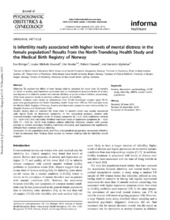| dc.contributor.author | Biringer, Eva Aaker | en_US |
| dc.contributor.author | Howard, Louise Michele | en_US |
| dc.contributor.author | Kessler, Ute | en_US |
| dc.contributor.author | Stewart, Robert | en_US |
| dc.contributor.author | Mykletun, Arnstein | en_US |
| dc.date.accessioned | 2016-01-27T13:06:18Z | |
| dc.date.available | 2016-01-27T13:06:18Z | |
| dc.date.issued | 2015 | |
| dc.Published | Journal of Psychosomatic Obstetrics and Gynaecology 2015, 36(2):38-45 | eng |
| dc.identifier.issn | 0167-482X | |
| dc.identifier.uri | https://hdl.handle.net/1956/11003 | |
| dc.description.abstract | Objective: To explore the effect of ever having tried to conceive for more than 12 months on levels of anxiety and depressive symptoms and to investigate if symptom levels of anxiety and depression in infertile women who remain childless, or go on to have children, respectively, differ from symptom levels in mothers without reports of infertility. Methods: Analyses were based on information from 12 584 Norwegian women aged 19–45 years who participated in the North-Trøndelag Health Study from 1995 to 1997 and data from the Medical Birth Registry of Norway. Anxiety and depressive symptoms were measured by the Hospital Anxiety and Depression Scale. Results: Having tried to conceive for more than 12 months (ever) was weakly associated with higher levels of depressive symptoms. In the categorical analyses, women with resolved infertility had higher levels of anxiety symptoms (B = 0.25 (95% confidence interval (CI) = 0.04–0.47)) and voluntarily childfree had lower levels of depressive symptoms (B = –0.05 (95% CI = –0.50 to –0.21)) than mothers without infertility. However, women with current primary or current secondary infertility had levels of anxiety and depression not significantly different from mothers without infertility. Conclusion: At the population level, and from a longitudinal perspective, unresolved infertility is less burdensome than findings from studies on women seeking help for infertility would suggest. | en_US |
| dc.language.iso | eng | eng |
| dc.publisher | Taylor & Francis | eng |
| dc.rights | Attribution CC BY | eng |
| dc.rights.uri | http://creativecommons.org/Licenses/by/4.0/ | eng |
| dc.subject | Anxiety | eng |
| dc.subject | Depression | eng |
| dc.subject | Epidemiology | eng |
| dc.subject | HUNT study | eng |
| dc.subject | infertility | eng |
| dc.subject | MBRN | eng |
| dc.subject | Mental health | eng |
| dc.subject | population | eng |
| dc.title | Is infertility really associated with higher levels of mental distress in the female population? Results from the North-Trondelag Health Study and the Medical Birth Registry of Norway | en_US |
| dc.type | Peer reviewed | |
| dc.type | Journal article | |
| dc.date.updated | 2015-12-30T16:58:11Z | |
| dc.description.version | publishedVersion | en_US |
| dc.rights.holder | Copyright 2015 Informa UK Ltd | |
| dc.identifier.doi | https://doi.org/10.3109/0167482x.2014.992411 | |
| dc.identifier.cristin | 1197725 | |
| dc.subject.nsi | VDP::Medisinske fag: 700::Helsefag: 800::Epidemiologi medisinsk og odontologisk statistikk: 803 | |
| dc.subject.nsi | VDP::Midical sciences: 700::Health sciences: 800::Epidemiology, medical and dental statistics: 803 | |

